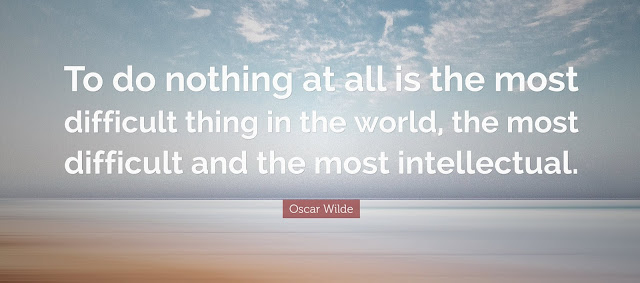DO NOTHING
These series of post are mainly
my own LIMITED thoughts and experience from practicing Yiquan and should be
taken with a HUGE DOSE OF SALT.
Oscar Wilde in his article “THE
CRITIC AS ARTIST: WITH SOME REMARKS UPON THE IMPORTANCE OF DOING NOTHING” had
this to say about CONTEMPLATION!
“[Contemplation]… in the opinion of the highest culture, it is the
proper occupation of man. I said to you some time ago that it was far more difficult
to talk about a thing than to do it. Let me say to you now that to do nothing at all is the most
difficult thing in the world, the most difficult and the most intellectual. To
Plato, with his passion for wisdom, this was the noblest form of energy. To
Aristotle, with his passion for knowledge, this was the noblest form of energy
also. It was to this that the passion for holiness led the saint and the mystic
of mediaeval days.”
What has this to do with
Yiquan, you may ask? Well, isn’t zhan zhuang the basic foundation of our
practice? We practice standing meditation, deep in contemplation. We attempt to
deepen the understanding of ourselves, both physically and mentally.
Rather than launching of then
to a discussion of psychology and spiritual matters, let us discuss this
concept in more concrete and simpler terms. In Zhan Zhuang, our practice is to
achieve Integrity and use the entire body. This requires deep contemplation to
reactive the muscles, tendons and ligaments that are underutilized, the
so-called grey to black zones that I wrote here.
However,
the obverse is equally difficult. The yellow to red zones are areas of the body
we tend to activate first and over-utilise. In our practice, we need to
exercise extreme mindfulness to relax these areas and minimize using them as
much as possible. This in only possible via CONTEMPLATION or DO NOTHING. From personal experience, trying to
lessen the usage of the yellow to red zones is TWICE as difficult as reactivating
the grey and black zones in my body. Why is this so?
Let us
focus on the area of our bodies we tend to use the most often, the knees and
shoulders.
1. The Knees
It is a
common to find that the elderly people have problem walking mostly due to the
pain in their knees. Why then, can we find some elderly people well into their
80s or 90s that have very little difficulty walking? Is this due to their
superior genetics or nutrition? Or is it due to their exercise regime?
The main
problem is that whilst instead of using the entire body to walk, especially the
hips, kua and buttocks, most people use their knee joints to bear the entire load
of walking. This is especially pronounced when you see people walking up the
stairs. Instead of using the back leg to push off with the assistance of the
kua, most people use the knees in the front leg to walk. You can refer to the link
here for
illustration.
2. The shoulders
The same
occurs for the shoulders. In using our arms or pushing hands, the shoulder
joints in the front part of the body is used extensively. However, we underutilize
the muscles and joints in the back of the body and under the armpits. Hence,
the energy that we direct is not ‘grounded’ and tends to dissipate.
We need to
contemplate as to what INTEGRITY actually means! In simple terms, a chain is
only as strong as its’ weakest link. There are two components here:
(a) Weakest link
Most people seize on this
component and focus exclusively on their weak areas. The reactivation of the
grey to black zones here is important. Indeed, this is crucial to improvement
in Zhan Zhuang. However, we tend to forget the second component:
(b) Strongest link
If certain areas of my body are
already STRONG, why should I bother focusing on it? What’s the purpose? We need
to remember, what is STRONG may also be BRITTLE. The so-called STRONG areas of
the body are not actually INHERENTLY strong at all. After all, all parts of the
body are made of the same material, so why should certain parts be stronger
than others? These areas are only STRONG because they are areas of the body we
tend to utilize the most. Hence, they may be more muscular due to repeated
stress and usage.
In Yiquan, to achieve
STRUCTURAL INTEGRITY and HARMONY, we must make the effort to activate the weak
links in our body. At the same time, we MUST NOT forget the OBVERSE! We must minimize
the excessive activation and strain in the so-called ‘STRONGEST LINK’ in our
body.
That’s the main point of ‘DO
NOTHING’ in this post. In your Yiquan practice, there will come a time where
you’re asked to do certain exercises. Normally, you will use certain parts of
the body to perform the exercise, usually the front part of the body. Even
though externally, this exercise appears the same as what you’re mimicking, you’ll
be told you’re doing it wrong. You’ll be asked to do it using the back part of
the body. And you’ll find this incredible hard to do. Hopefully this post will make
more sense once you reach this stage and you’ll begin to understand why it is
so hard to ‘DO NOTHING!’

